Research Progress of Biomimetic Memristor Flexible Synapse
Abstract
:1. Introduction
2. Flexible Memristor Material
2.1. Flexible Electrode Material
2.2. Flexible Dielectric Layer Material
2.2.1. Metal Oxide Flexible Memristor
2.2.2. Organic Polymers Flexible Memristor
2.2.3. Two-Dimensional Materials: Flexible Memristor
2.2.4. Biodegradable Materials: Flexible Memristor
2.3. Flexible Substrate Material
3. Flexible Memristor Structure
3.1. Flexible “Sandwich” Structure
3.2. Flexible Plane Structure
3.3. Flexible Crossbar Structure
4. Application of Flexible Memristor
5. Conclusions
Funding
Institutional Review Board Statement
Informed Consent Statement
Conflicts of Interest
References
- Volta, A.; Banks, J. On the electricity excited by the mere contact of conducting substances of different kinds. Philos. Mag. 1800, 28, 289–311. [Google Scholar] [CrossRef] [Green Version]
- Chua, L. Memristor-The missing circuit element. IEEE Trans. Circuit Theory 1971, 18, 507–519. [Google Scholar] [CrossRef]
- Chen, Y.; Liu, G.; Wang, C. Polymer memristor for information storage and neuromorphic applications. Mater. Horiz. 2014, 1, 489–506. [Google Scholar] [CrossRef]
- Strukov, D.B.; Snider, G.S.; Stewart, D.R. Erratum: The missing memristor found. Nature 2009, 459, 1154. [Google Scholar] [CrossRef]
- Wang, W.; Wang, M.; Ambrosi, E. Surface diffusion-limited lifetime of silver and copper nanofilaments in resistive switching devices. Nat. Commun. 2019, 10, 81. [Google Scholar] [CrossRef] [Green Version]
- Ielmini, D.; Wong, H.S.P. In-memory computing with resistive switching devices. Nat. Electron. 2018, 1, 333–343. [Google Scholar] [CrossRef]
- Yang, Y.; Zhang, X.; Qin, L. Probing nanoscale oxygen ion motion in memristive systems. Nat. Commun. 2017, 8, 15173. [Google Scholar] [CrossRef] [PubMed] [Green Version]
- Long, S.B.; Liu, Q.; Lu, H.B.; Liu, M. Research progress of resistive random access memory. Natl. Sci. Phys. Mech. Astron. 2016, 46, 145–171. [Google Scholar]
- Pan, F.; Gao, S.; Chen, C. Recent progress in resistive random access memories: Materials, switching mechanisms, and performance. Mater. Sci. Eng. R Rep. 2014, 83, 1–59. [Google Scholar] [CrossRef]
- Sun, B.W.; Qian, K.; Wang, Q.P. Research progress of flexible memristor. Micro Nano Electron. Intell. Manuf. 2019, 1, 76–86. [Google Scholar]
- Sugisaki, E.; Fukushima, Y.; Tsukada, M.; Aihara, T. Cholinergic modulation on spike timing-dependent plasticity in hippocampal CA1 network. Neuroscience 2011, 192, 91–101. [Google Scholar] [CrossRef] [PubMed]
- Ohno, T.; Hasegawa, T.; Tsuruoka, T.; Terabe, K.; Gimzewski, J.K.; Aono, M. Short-term plasticity and long-term potentiation mimicked in single inorganic synapses. Nat. Mater. 2011, 10, 591–595. [Google Scholar] [CrossRef] [PubMed]
- Hu, S.G.; Liu, Y.; Liu, Z.; Chen, T.P.; Wang, J.J.; Yu, Q.; Deng, L.J.; Yin, Y.; Hosaka, S. Associative memory realized by a configurable memristive Hopfiled neural network. Nat. Commun. 2015, 6, 7522. [Google Scholar] [CrossRef] [PubMed] [Green Version]
- Prezioso, M.; Merrikh-Bayat, F.; Hoskins, B.D.; Adam, G.C.; Likharev, K.K.; Strukov, D.B. Training and operation of an integrated neuromorphic network based on metal-oxide memristors. Nature 2015, 521, 61–64. [Google Scholar] [CrossRef] [PubMed] [Green Version]
- Ho, V.M.; Lee, J.A.; Martin, K.C. The cell biology of synaptic plasticity. Science 2011, 334, 623–628. [Google Scholar] [CrossRef] [Green Version]
- Shi, C.; Yang, J.; Han, Y.; Cao, Z.; Qin, Q.; Liu, L.; Wu, N.J.; Wang, Z. A 1000 fps Vision Chip Based on a Dynamically Reconfigurable Hybrid Architecture Comprising a PE Array Processor and Self-Organizing Map Neural Network. IEEE J. Solid-State Circuits 2014, 49, 2067–2082. [Google Scholar] [CrossRef]
- Mohamed, G.; Muhammad, H. Review on physically flexible nonvolatile memory for internet of everything electronics. Electronics 2017, 4, 424–479. [Google Scholar]
- Li, L.; Chang, K.C.; Ye, C.; Lin, X.; Zhang, R.; Xu, Z.; Zhou, Y.; Xiong, W.; Kuo, T.P. An indirect way to achieve comprehensive performance improvement of resistive memory: When hafnium meets ITO in an electrode. Nanoscale 2020, 12, 3267–3272. [Google Scholar] [CrossRef] [PubMed]
- Seo, S.; Lim, J.; Lee, S.; Alimkhanuly, B.; Lee, S. Graphene-edge electrode on a cu-based chalcogenide selector for 3D vertical memristor cells. ACS Appl. Mater. Interfaces 2019, 46, 43466–43472. [Google Scholar] [CrossRef] [PubMed]
- Sun, J.; Tan, J.B.; Chen, T. HfO-based RRAM device with sandwich-like electrode for thermal budget requirement. IEEE Trans. Electron. Devices 2020, 67, 4193–4200. [Google Scholar] [CrossRef]
- Yun, H.J.; Choi, B.J. Effects of moisture and electrode material on AlN-based resistive random access memory. Ceram. Int. 2019, 45, 16311–16316. [Google Scholar] [CrossRef]
- Li, Y.; Li, R.; Peng, Y.; Gao, X.; Chen, E. Low-cost bidirectional selector based on Ti/TiO2/HfO2/TiO2/Ti stack for bipolar rram arrays. Mod. Phys. Lett. B 2015, 29, 1550244. [Google Scholar] [CrossRef]
- Wang, H.; Zhu, B.; Ma, X.; Hao, Y.; Chen, X. Physically transient resistive switching memory based on silk protein. Small 2016, 12, 2715–2719. [Google Scholar] [CrossRef]
- Li, X.; Zhang, L.; Guo, R.; Chen, J.; Yan, X. A flexible transient biomemristor based on hybrid structure HfO2/BSA:Au double layers. Adv. Mater. Technol. 2020, 5, 2000191. [Google Scholar] [CrossRef]
- Zaitsev, S.V.; Cherkashina, N.I.; Pavlenko, V.I.; Prochorenkov, D.S. Formation and stability of W coating on a flexible polyimide substrate. Thin Solid Films 2020, 715, 138424. [Google Scholar] [CrossRef]
- Nagareddy, V.K.; Barnes, M.D.; Zipoli, F.; Lai, K.T.; Alexeev, A.M.; Craciun, M.F. Multilevel ultrafast flexible nanoscale nonvolatile hybrid graphene oxide-titanium oxide memories. ACS Nano 2017, 11, 3010. [Google Scholar] [CrossRef] [PubMed] [Green Version]
- Sokolov, A.S.; Jeon, Y.R.; Ku, B.; Choi, C. Ar ion plasma surface modification on the heterostructured TaOx/InGaZnO thin films for flexible memristor synapse. J. Alloy. Compd. 2020, 822, 153625. [Google Scholar] [CrossRef]
- Ismail, M.; Rana, A.M.; Talib, I.; Tsai, T.S.; Hussain, M. Room-temperature fabricated, fully transparent resistive memory based on ITO/CeO2/ITO structure for rram applications. Solid State Commun. 2014, 202, 28–34. [Google Scholar] [CrossRef]
- Mundle, R.; Carvajal, C.; Pradhan, A.K. ZnO/Al:ZnO transparent resistive switching devices grown by atomic layer deposition for memristor applications. Langmuir 2016, 32, 4983. [Google Scholar] [CrossRef] [PubMed]
- Shang, J.; Xue, W.; Ji, Z.; Liu, G.; Niu, X.; Yi, X.; Pan, l.; Zhang, Q.; Xu, X.H.; Li, R.W. Highly flexible resistive switching memory based on amorphous-nanocrystalline hafnium oxide films. Nanoscale 2017, 9, 7037–7046. [Google Scholar] [CrossRef] [Green Version]
- Yi, Z.; Liu, D.; Wang, J.; Cheng, Z.Q.; Yu, X. Black phosphorus based multi-color light-modulated transparent memristor with enhanced resistive switching performance. ACS Appl. Mater. Interfaces 2020, 12, 25108–25114. [Google Scholar]
- Le, V.Q.; Do, T.H.; Retamal, J.; Shao, P.W.; Lai, Y.H.; Wu, W.W.; He, J.H.; Chueh, Y.L.; Chu, Y.H. Van der Waals heteroepitaxial AZO/NiO/AZO/muscovite (ANA/muscovite) transparent flexible memristor. Nano Energy 2018, 56, 322–329. [Google Scholar] [CrossRef]
- Qian, K.; Tay, R.Y.; Lin, M.F.; Chen, J.; Li, H.; Lin, J.; Wang, J.; Cai, G.; Nguyen, V.C.; Teo, E.H.T. Direct observation of indium conductive filaments in transparent, flexible, and transferable resistive switching memory. ACS Nano 2017, 11, 1712–1718. [Google Scholar] [CrossRef] [PubMed]
- Yin, Y.M.; Cheng, H.F.; Liu, D.Q.; Zhang, C.Y. Research progress of oxide memristor materials and their resistance switching mechanism. Electron. Compon. Mater. 2016, 35, 9–14. [Google Scholar]
- Zhang, L.; Gong, T.; Wang, H.D.; Guo, Z.N.; Zhang, H. Memristive devices based on emerging two-dimensional materials beyond graphene. Nanoscale 2019, 11, 12413–12435. [Google Scholar] [CrossRef] [PubMed]
- Shi, C.Y.; Min, G.Z.; Liu, X.Y. Research progress of protein-based memristors. J. Phys. 2020, 69, 107–129. [Google Scholar] [CrossRef]
- Son, D.; Lee, J.; Qiao, S.; Ghaffari, R.; Kim, J.; Ji, E.L.; Song, C.; Kin, S.J.; Dong, J.L.; Jun, S.W. Multifunctional wearable devices for diagnosis and therapy of movement disorders. Nat. Nanotechnol. 2014, 9, 397–404. [Google Scholar] [CrossRef] [PubMed]
- Zhang, J.; Wang, F.; Li, C.; Shan, X.; Zhang, K. Insight into Interface behavior and microscopic switching mechanism for flexible HfO2 RRAM. Appl. Surf. Sci. 2020, 526, 146723. [Google Scholar] [CrossRef]
- Jo, J.; Kang, S.; Heo, J.S.; Kim, Y.; Park, S.K. Flexible metal oxide semiconductor devices made by solution methods. Chemistry 2020, 26, 9126–9156. [Google Scholar] [CrossRef] [PubMed]
- Paul, A.D.; Biswas, S.; Das, P.; Edwards, H.J.; Mahapatra, R. Effect of aluminum doping on performance of HfO-based flexible resistive memory devices. IEEE Trans. Electron. Devices 2020, 67, 4222–4227. [Google Scholar] [CrossRef]
- Deng, T.; Ye, C.; Wang, H.; Wu, J.; He, P. Improved performance of ITO/TiO2/HfO2/Pt random resistive accessory memory by nitrogen annealing treatment. Microelectron. Reliab. 2016, 57, 34–38. [Google Scholar] [CrossRef]
- Ryu, J.H.; Kim, S. Artificial synaptic characteristics of TiO2/HfO2 memristor with self-rectifying switching for brain-inspired computing. Chaos Solitons Fractals 2020, 140, 110236. [Google Scholar] [CrossRef]
- Zhang, R.; Huang, H.; Xia, Q.; Ye, C.; Wei, X.; Wang, J.; Zhang, L.; Zhu, L.Q. Role of oxygen vacancies at the TiO2/HfO2 interface in flexible oxide-based resistive switching memory. Adv. Electron. Mater. 2019, 5, 1800833. [Google Scholar] [CrossRef]
- Kumar, D.; Chand, U.; Siang, L.W.; Tseng, T.Y. High-performance TiN/Al2O3/ZnO/Al2O3/TiN flexible RRAM device with high bending condition. IEEE Trans. Electron. Devices 2020, 67, 493–498. [Google Scholar] [CrossRef]
- Fang, S.L.; Liu, W.H.; Li, X.; Wang, X.L.; Han, C.Y. Biodegradable transient resistive random-access memory based on MoO3 /MgO/MoO3 stack. Appl. Phys. Lett. 2019, 115, 244102. [Google Scholar] [CrossRef]
- Lin, W.P.; Liu, S.J.; Gong, T.; Zhao, Q.; Huang, W. Polymer-based resistive memory materials and devices. Adv. Mater. 2014, 26, 570–606. [Google Scholar] [CrossRef] [PubMed]
- Wang, T.Y.; He, Z.Y.; Liu, H.; Chen, L.; Zhu, H.; Sun, Q.Q.; Ding, S.J.; Zhou, P.; Zhang, D.W. Flexible electronic synapses for face recognition application with multi-modulated conductance states. ACS Appl. Mater. Interfaces 2018, 10, 37345–37352. [Google Scholar] [CrossRef] [PubMed]
- Jang, B.C.; Kim, S.; Yang, S.Y.; Park, J.; Cha, J.H.; Oh, J.; Choi, J.; Im, S.G.; Dravid, V.P.; Choi, S.Y. Polymer analog memristive synapse with atomic-scale conductive filament for flexible neuromorphic computing system. Nano Lett. 2019, 19, 839–849. [Google Scholar] [CrossRef] [PubMed]
- Yalagala, B.; Khandelwal, S.; Deepika, J.; Badhulika, S. Wirelessly destructible MgO-PVP-graphene composite based flexible transient memristor for security applications. Mater. Sci. Semicond. Process. 2019, 104, 104673. [Google Scholar] [CrossRef]
- Lv, Z.; Hu, Q.; Xu, Z.X.; Wang, J.; Chen, Z.; Wang, Y.; Chen, M.; Zhou, K.; Zhou, Y.; Han, S. Organic memristor utilizing copper phthalocyanine nanowires with infrared response and cation regulating properties. Adv. Electron. Mater. 2019, 5, 1800793. [Google Scholar] [CrossRef]
- Yang, Y.; Gao, P.; Li, L.; Pan, X.; Tappertzhofen, S.; Choi, S.H.; Waser, R.; Valov, I.; Lu, W.D. Electrochemical dynamics of nanoscale metallic inclusions in dielectrics. Nat. Commun. 2014, 5, 4232. [Google Scholar] [CrossRef] [PubMed] [Green Version]
- Ren, Y.; Chang, C.L.; Ting, L.Y.; Zhou, L.; Mao, J.Y.; Zhang, S.R.; Chou, H.H.; Yang, J.Q.; Zhou, Y.; Hun, S.T. Flexible pyrene/phenanthro imidazole-based memristive devices for mimicking synaptic plasticity. Adv. Intell. Syst. 2019, 1, 199998. [Google Scholar] [CrossRef] [Green Version]
- Park, H.; Kim, M.; Lee, S. Introduction of interfacial load polymeric layer to organic flexible memristor for regulating conductive filament growth. Adv. Electron. Mater. 2020, 6, 2000582. [Google Scholar] [CrossRef]
- Lee, S.H.; Park, H.L.; Kim, M.H.; Kang, S.; Lee, S.D. Interfacial triggering of conductive filament growth in organic flexible memristor for high reliability and uniformity. ACS Appl. Mater. Interfaces 2019, 11, 30108–30115. [Google Scholar] [CrossRef] [PubMed]
- Gu, M.; Zhao, Z.; Liu, J.; Liu, G.; Chen, Y. Conjugated polymer covalently modified multi-walled carbon nanotubes for flexible nonvolatile RRAM devices. Eur. Polym. J. 2021, 142, 110153. [Google Scholar] [CrossRef]
- Chen, Q.; Wang, Z.; Lin, M.; Qi, X.; Huang, R. Homogeneous 3D vertical integration of parylene-C based organic flexible resistive memory on standard CMOS platform. Adv. Electron. Mater. 2021, 7, 2000864. [Google Scholar] [CrossRef]
- Liang, L.; Li, K.; Xiao, C.; Fan, S.; Liu, J.; Zhang, W.; Xu, W.; Tong, W.; Liao, J.; Zhou, Y.; et al. Vacancy associates-rich ultrathin nanosheets for high performance and flexible nonvolatile memory device. J. Am. Chem. Soc. 2015, 137, 3102–3108. [Google Scholar] [CrossRef] [PubMed]
- Bertolazzi, S.; Bondavalli, P.; Roche, S.; San, T.; Choi, S.Y.; Colombo, L.; Bonaccorso, F.; Samorì, P. Nonvolatile memories based on graphene and related 2D materials. Adv. Mater. 2019, 31, 1806663. [Google Scholar] [CrossRef] [PubMed] [Green Version]
- Wang, M.; Cai, S.; Pan, C.; Wang, C.; Lian, X.; Zhuo, Y.; Xu, K.; Cao, T.; Pan, X.; Wang, B. Robust memristors based on layered two-dimensional materials. Nat. Electron. 2018, 1, 130–136. [Google Scholar] [CrossRef] [Green Version]
- Shen, Z.; Zhao, C.; Qi, Y.; Mitrovic, I.Z.; Zhao, C. Memristive non-volatile memory based on graphene materials. Micromachines 2020, 11, 341. [Google Scholar] [CrossRef] [PubMed] [Green Version]
- Pumera, M.; Sofer, Z. Towards stoichiometric analogues of graphene: Graphane, fluorographene, graphol, graphene acid and others. Chem. Soc. Rev. 2017, 46, 4450–4463. [Google Scholar] [CrossRef] [Green Version]
- Abunahla, H.; Halawani, Y.; Alazzam, A.; Mohammad, B. NeuroMem: Analog graphene-based resistive memory for artificial neural networks. Sci. Rep. 2020, 10, 9473. [Google Scholar] [CrossRef] [PubMed]
- Song, X.; Hu, J.; Zeng, H. Two-dimensional semiconductors: Recent progress and future perspectives. J. Mater. Chem. 2013, 1, 2952–2969. [Google Scholar] [CrossRef]
- Illarionov, Y.Y.; Rzepa, G.; Waltl, M.; Knobloch, T.; Grasser, T. The role of charge trapping in MoS2/SiO2 and MoS2/hBN field-effect transistors. Sci. China 2016, 3, 035004. [Google Scholar]
- Qian, K.; Tay, R.Y.; Nguyen, V.C.; Wang, J.; Cai, G.; Chen, T.; Teo, E.H.T.; Lee, P.S. Hexagonal boron nitride thin film for flexible resistive memory applications. Adv. Funct. Mater. 2016, 26, 2176–2184. [Google Scholar] [CrossRef]
- Siddiqui, G.U.; Rehman, M.M.; Yang, Y.J.; Choi, K.H. A two-dimensional hexagonal boron nitride/polymer nanocomposite for flexible resistive switching devices. J. Mater. Chem. 2017, 5, 862–871. [Google Scholar] [CrossRef]
- Ge, R.; Wu, X.; Kim, M.; Shi, J.; Sonde, S.S.; Tao, L.; Zhang, Y.; Jack, L.; Akinwande, D. Atomristor: Nonvolatile resistance switching in atomic sheets of transition metal dichalcogenides. Nano Lett. 2018, 18, 434–441. [Google Scholar] [CrossRef] [PubMed]
- Qu, Y.; Kang, J.; Shao, Z.; Zhang, X.; Chang, S.; Wang, G.; Qin, S.; Li, J. Mechanical and electronic properties of monolayer MoS2 under elastic strain. Phys. Lett. A 2012, 376, 1166–1170. [Google Scholar]
- Zhao, X.; Fan, Z.; Xu, H.; Wang, Z.; Xu, J.; Ma, J.; Liu, Y. Reversible alternation between bipolar and unipolar resistive switching in Ag/MoS2/Au structure for multilevel flexible memory. J. Mater. Chem. C 2018, 6, 7195–7200. [Google Scholar] [CrossRef]
- Jha, R.K.; Guha, P.K. Liquid exfoliated pristine WS2 nanosheets for ultrasensitive and highly stable chemiresistive humidity sensors. Nanotechnology 2016, 27, 475503. [Google Scholar] [CrossRef] [PubMed]
- Lee, J.H.; Wu, C.; Sung, S.; An, H.; Kim, T.W. Highly flexible and stable resistive switching devices based on WS2 nanosheets:poly(methylmethacrylate) nanocomposites. Sci. Rep. 2019, 9, 19316. [Google Scholar] [CrossRef] [PubMed]
- He, H.K.; Yang, F.F.; Yang, R. Flexible full two-dimensional memristive synapses of graphene/WSe2–XOy/graphene. Phys. Chem. Chem. Phys. 2020, 22, 20658–20664. [Google Scholar] [CrossRef]
- Lou, Z.; Wang, L.L.; Jiang, K.; Wei, Z.G.; Shen, G.Z. Reviews of wearable healthcare systems: Materials, devices and system integration. Mater. Sci. Eng. R Rep. 2020, 140, 100523. [Google Scholar] [CrossRef]
- Wang, J.J.; Qian, F.S.; Huang, S.M.; Lv, Z.Y. Recent progress of protein-based data storage and neuromorphic devices. Adv. Intell. Syst. 2020, 3, 20000180. [Google Scholar]
- Kook, G.; Jeong, S.; Kim, S.H.; Kim, M.K.; Lee, S.; Cho, I.; Choi, N. Wafer-Scale Multilayer Fabrication for Silk Fibroin-Based Microelectronics. ACS Appl. Mater. Interfaces 2019, 11, 115–124. [Google Scholar] [CrossRef] [PubMed]
- Bae, H.; Kim, D.; Seo, M.; Jin, I.K.; Choi, Y. Bioinspired polydopamine ased resistive log witching memory on cotton fabric for wearable neuromorphic device applications. Adv. Mater. Technol. 2019, 4, 1900151. [Google Scholar] [CrossRef]
- He, X.; Zhang, J.; Wang, W.; Xuan, W.; Wang, X.Z.; Zhang, Q.; Smith, C.G.; Luo, J. Transient resistive switching devices made from egg albumen dielectrics and dissolvable electrodes. ACS Appl. Mater. Interfaces 2016, 8, 10954–10960. [Google Scholar] [CrossRef] [PubMed]
- Yan, X.; Li, X.; Zhou, Z.; Zhao, J.; Wang, H.; Wang, J.; Zhang, L.; Ren, D.; Zhang, X.; Chen, J. A flexible transparent organic artificial synapse based on tungsten /egg albumen/indium tin oxide/polyethylene terephthalate memristor. ACS Appl. Mater. Interfaces 2019, 11, 18654–18661. [Google Scholar] [CrossRef] [PubMed]
- Chang, Y.C.; Lee, C.J.; Wang, L.W.; Wang, Y.H. Air-stable gelatin composite memory devices on a paper substrate. Org. Electron. 2019, 65, 77–81. [Google Scholar] [CrossRef]
- Liu, S.T.; Dong, S.R.; Wang, X.G.; Shi, L.; Xu, H.S.; Huang, S.Y.; Luo, J.K. Flexible and fully biodegradable resistance random access memory based on a gelatin dielectric. Nanotechnology 2020, 31, 255204. [Google Scholar] [CrossRef]
- Bavandpour, M.; Bagheri-Shouraki, S.; Soleimani, H. Spiking neuro-fuzzy clustering system and its memristor crossbar based implementation. Microelectron. J. 2014, 45, 1450–1462. [Google Scholar] [CrossRef]
- Kook, G.; Jeong, S.; Mi, K.K.; Lee, S.; Choi, N.; Lee, H.J. Fabrication of highly dense silk fibroin biomemristor array and its resistive switching characteristics. Adv. Mater. Technol. 2020, 5, 1900991. [Google Scholar] [CrossRef]
- Park, Y.; Lee, J.S. Flexible multistate data storage devices fabricated using natural lignin at room temperature. ACS Appl. Mater. Interfaces 2017, 9, 6207–6212. [Google Scholar] [CrossRef]
- Lam, J.Y.; Jang, G.W.; Huang, C.J.; Tung, S.H.; Chen, W.C. Environmentally friendly resistive switching memory devices with DNA as active layer and bio-based polyethylene furanoate as substrate. ACS Sustain. Chem. Eng. 2020, 8, 5100–5106. [Google Scholar] [CrossRef]
- Dong, Z.; He, Y.; Hu, X.; Qi, D.; Duan, S. A flexible memristor-based logic unit circuit and its network integration for boolean logic implementation. IET Nanodielectr. 2019, 2, 61–69. [Google Scholar] [CrossRef]
- Lu, Y.; Chen, W.L.; Gao, S.; Li, R.W. Research progress of flexible resistive memory materials and devices. Mater. Guide 2020, 1, 146–154. [Google Scholar]
- Liu, Y.C.; Lin, Y.; Wang, Z.Q.; Xu, H.Y. Oxide-based memristive neurosynaptic device. J. Phys. 2019, 68, 119–137. [Google Scholar]
- Yong, J.; Hassan, B.; Liang, Y.; Ganesan, K.; Rajasekharan, R.; Evans, R.; Egan, G.; Kavehei, O.; Li, J.; Chana, G.; et al. A silk fibroin bio-transient solution processable memristor. Sci. Rep. 2017, 7, 14731. [Google Scholar] [CrossRef] [PubMed]
- Chen, Z.H.; Liu, Z.; Ma, W.K.; Shen, Y.K.; Zhang, H.Y.; Chen, T.P. Resistive switching characteristics of RRAM devices based on spin-coated a-IGZO thin films and ink-jet printed Ag electrodes. In Proceedings of the 2016 IEEE International Nanoelectronics Conference (INEC), Chengdu, China, 9–11 May 2016; pp. 1–2. [Google Scholar] [CrossRef]
- Lien, D.H.; Kao, Z.K.; Huang, T.H.; Liao, Y.C.; Lee, S.C.; He, J.H. All-printed paper memory. ACS Nano 2014, 8, 7613–7619. [Google Scholar] [CrossRef] [PubMed]
- Yan, X.; Zhou, Z.; Zhao, J.; Liu, Q.; Wang, H.; Yuan, G.; Chen, J. Flexible memristors as electronic synapses for neuro-inspired computation based on scotch tape-exfoliated mica substrates. Nano Res. 2018, 11, 1183–1192. [Google Scholar] [CrossRef]
- Zhang, C.; Tai, Y.T.; Jie, S.; Gang, L.; Li, R. Synaptic plasticity and learning behaviours in flexible artificial synapse based on polymer/viologen system. J. Mater. Chem. C 2016, 4, 3217–3223. [Google Scholar] [CrossRef]
- Lin, Y.; Zeng, T.; Xu, H.; Wang, Z.; Zhao, X.; Liu, W.; Ma, J.; Liu, Y. Transferable and flexible artificial memristive synapse based on WOx schottky junction on arbitrary substrates. Adv. Electron. Mater. 2018, 4, 1800373. [Google Scholar] [CrossRef]
- Lee, S.; Kim, H.; Yun, D.J.; Rhee, S.W.; Yong, K. Resistive switching characteristics of ZnO thin film grown on stainless steel for flexible nonvolatile memory devices. Appl. Phys. Lett. 2009, 95, 262113. [Google Scholar] [CrossRef] [Green Version]
- Zhang, Z.; Yi, W.; Wong, H.; Wong, S.S. Nanometer-scale HfOx RRAM. IEEE Electron. Device Lett. 2013, 34, 1005–1007. [Google Scholar] [CrossRef]
- Yang, M.; Zhao, X.; Tang, Q.; Cui, N.; Wang, Z.; Tong, Y.; Liu, Y. Stretchable and conformable synapse memristors for wearable and implantable electronics. Nanoscale 2018, 10, 18135–18144. [Google Scholar] [CrossRef]
- Illarionov, G.A.; Kolchanov, D.S.; Kuchur, O.A.; Zhukov, M.V.; Morozov, M.I. Inkjet assisted fabrication of planar biocompatible memristors. RSC Adv. 2019, 9, 35998–36004. [Google Scholar] [CrossRef] [Green Version]
- Gabel, M.; Gu, Y. Understanding Microscopic Operating Mechanisms of a van der Waals Planar Ferroelectric Memristor. Adv. Funct. Mater 2021, 31, 2009999. [Google Scholar] [CrossRef]
- Sun, H.; Liu, Q.; Li, C.; Long, S.; Lv, H.; Bi, C.; Hui, Z.; Li, L.; Liu, M. Direct observation of conversion between threshold switching and memory switching induced by conductive filament morphology. Adv. Funct. Mater. 2014, 24, 5679–5696. [Google Scholar] [CrossRef]
- Zhuang, W.W.; Pan, W.; Ulrich, B.D.; Lee, J.J.; Stecker, L.; Burmaster, A.; Evans, D.R.; Hsu, S.T.; Tajiri, M.; Shimaoka, A.; et al. Novel colossal magnetoresistive thin film nonvolatile resistance random access memory (RRAM). In Digest. International Electron Devices Meeting; IEEE: Piscataway, NJ, USA, 2002; pp. 193–196. [Google Scholar] [CrossRef]
- Zhang, P.; Xu, B.; Gao, C.; Chen, G.; Gao, M. Facile synthesis of Co9Se8 quantum dots as charge traps for flexible organic resistive switching memory device. ACS Appl. Mater. Interfaces 2016, 8, 30336–30343. [Google Scholar] [CrossRef]
- Hu, S.; Yue, J.; Jiang, C.; Tang, X.; Huang, X.; Du, Z.; Wang, C. Resistive switching behavior and mechanism in flexible TiO2@Cf memristor crossbars. Ceram. Int. 2019, 45, 10182–10186. [Google Scholar] [CrossRef]
- Mountain, D.J.; Mclean, M.M.; Krieger, C.D. Memristor crossbar tiles in a flexible, general purpose neural processor. IEEE J. Emerg. Sel. Top. Circuits Syst. 2017, 8, 137–145. [Google Scholar] [CrossRef]
- Wang, T.Y.; Meng, J.L.; Rao, M.Y.; He, Z.Y.; Zhang, D.W. 3D nanoscale flexible memristor networks with ultralow power for information transmission and processing application. Nano Lett. 2020, 20, 4111–4120. [Google Scholar] [CrossRef]
- Pan, Q.; Su, M.; Zhang, Z.; Cai, Z.; Li, Y.; Huang, Z.; Qian, X.; Hu, X.; Li, F.; Dong, H.; et al. Fully printed flexible crossbar memory devices with tipnhanced micro/nanostructures. Adv. Electron. Mater. 2019, 5, 1900131. [Google Scholar] [CrossRef]
- West, M.J. Stereological methods for estimating the total number of neurons and synapses: Issues of precision and bias. Trends Neurosci. 1999, 22, 51–61. [Google Scholar] [CrossRef]
- Kang, S.; Lee, J.; Kang, M.; Song, Y. Achievement of gradual conductance characteristics based on interfacial phase-change memory for artificial synapse applications. Electronics 2021, 10, 408. [Google Scholar] [CrossRef]
- Gopalakrishnan, R. RRAM based neuromorphic algorithms. arXiv 2019, 1903, 02519. [Google Scholar]
- Yan, X.; Pei, Y.; Chen, H.; Zhao, J.; Zhou, Z.; Wang, H. Self-Assembled networked PbS distribution quantum dots for resistive switching and artificial synapse performance boost of memristors. Adv. Mater. 2019, 31, 1805284. [Google Scholar] [CrossRef] [PubMed]
- Qi, M.; Cao, S.; Yang, L.; You, Q.; Wu, Z. Uniform multilevel switching of graphene oxide-based RRAM achieved by embedding with gold nanoparticles for image pattern recognition. Appl. Phys. Lett. 2020, 116, 163503. [Google Scholar] [CrossRef]
- Moon, K.; Lim, S.; Park, J.; Sung, C.; Oh, S.; Woo, J.; Lee, J.; Hwang, H. RRAM-based synapse devices for neuromorphic systems. Faraday Discuss. 2019, 213, 421–451. [Google Scholar] [CrossRef] [PubMed]
- Sun, H.; Luo, Z.; Zhao, L.; Liu, C.; Li, X.G. BiFeO3-based flexible ferroelectric memristors for neuromorphic pattern recognition. ACS Appl. Electron. Mater. 2020, 4, 1081–1089. [Google Scholar] [CrossRef]
- Park, H.L.; Kim, M.H.; Kim, M.H.; Lee, S.H. Reliable organic memristors for neuromorphic computing by predefining a localized ion-migration path in crosslinkable polymer. Nanoscale 2020, 12, 22502–22510. [Google Scholar] [CrossRef] [PubMed]
- Lu, Q.; Sun, F.; Liu, L.; Li, L.; Zhang, T. Biological receptor-inspired flexible artificial synapse based on ionic dynamics. Microsyst. Nanoeng. 2020, 6, 84. [Google Scholar] [CrossRef] [PubMed]
- Wang, T.Y.; Meng, J.L.; He, Z.Y.; Chen, L.; Zhu, H.; Sun, Q.Q.; Ding, S.J.; Zhou, P.; Zhang, D.W. Room-temperature developed flexible biomemristor with ultralow switching voltage for array learning. Nanoscale 2020, 12, 9116–9123. [Google Scholar] [CrossRef]
- Ge, J.; Zhang, S.; Liu, Z.; Xie, Z.; Pan, S. Flexible artificial nociceptor using a biopolymer-based forming-free memristor. Nanoscale 2019, 11, 6591–6601. [Google Scholar] [CrossRef]
- Wang, Z.; Yue, J.; Jiang, C.; Abrahams, I.; Yu, T.; Li, Y.; Du, Z.; Huang, X.; Li, L.; Wang, G.; et al. Vacancy-induced resistive switching and synaptic behavior in flexible BST@Cf memristor crossbars. Ceram. Int. 2020, 46, 21569–21577. [Google Scholar] [CrossRef]


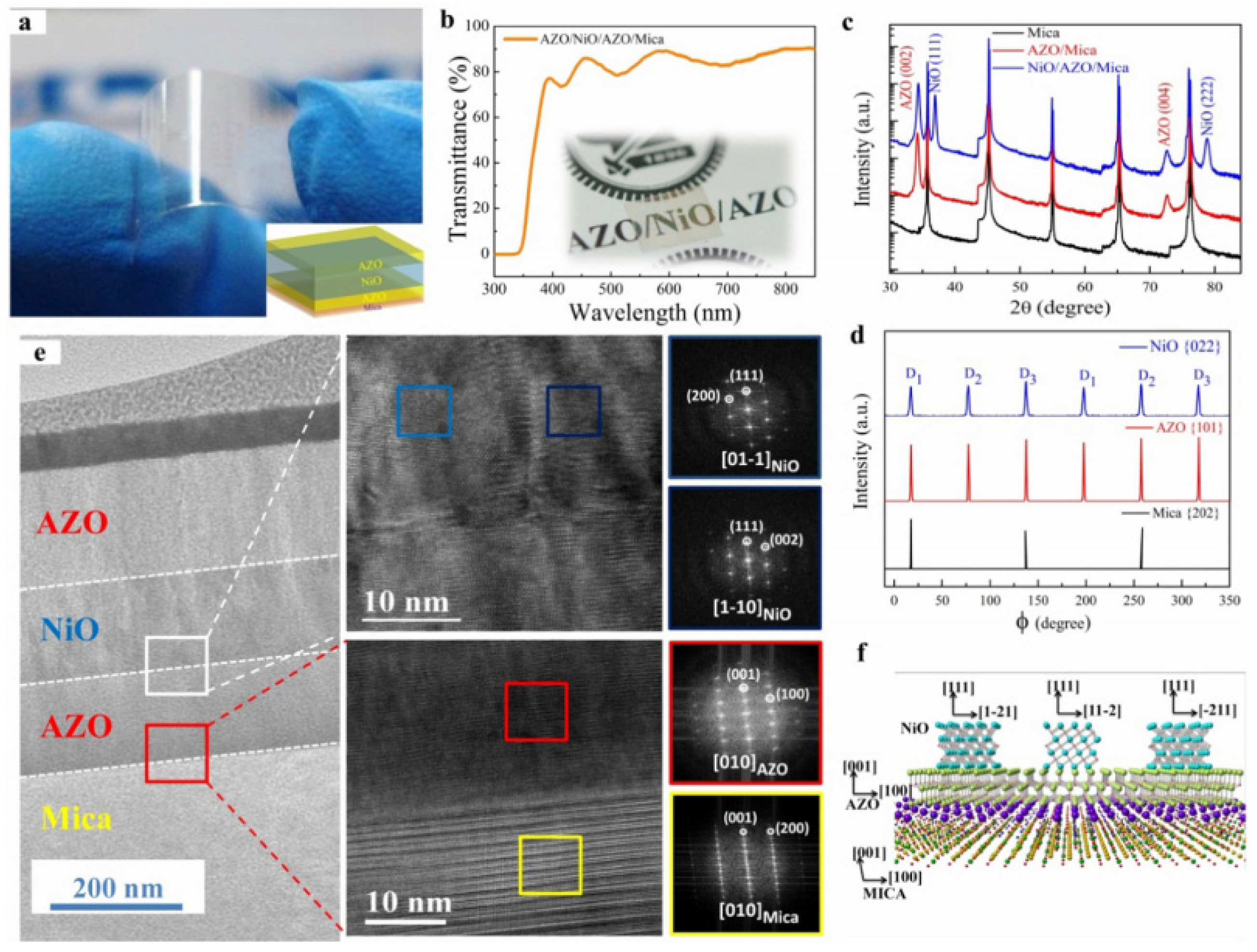


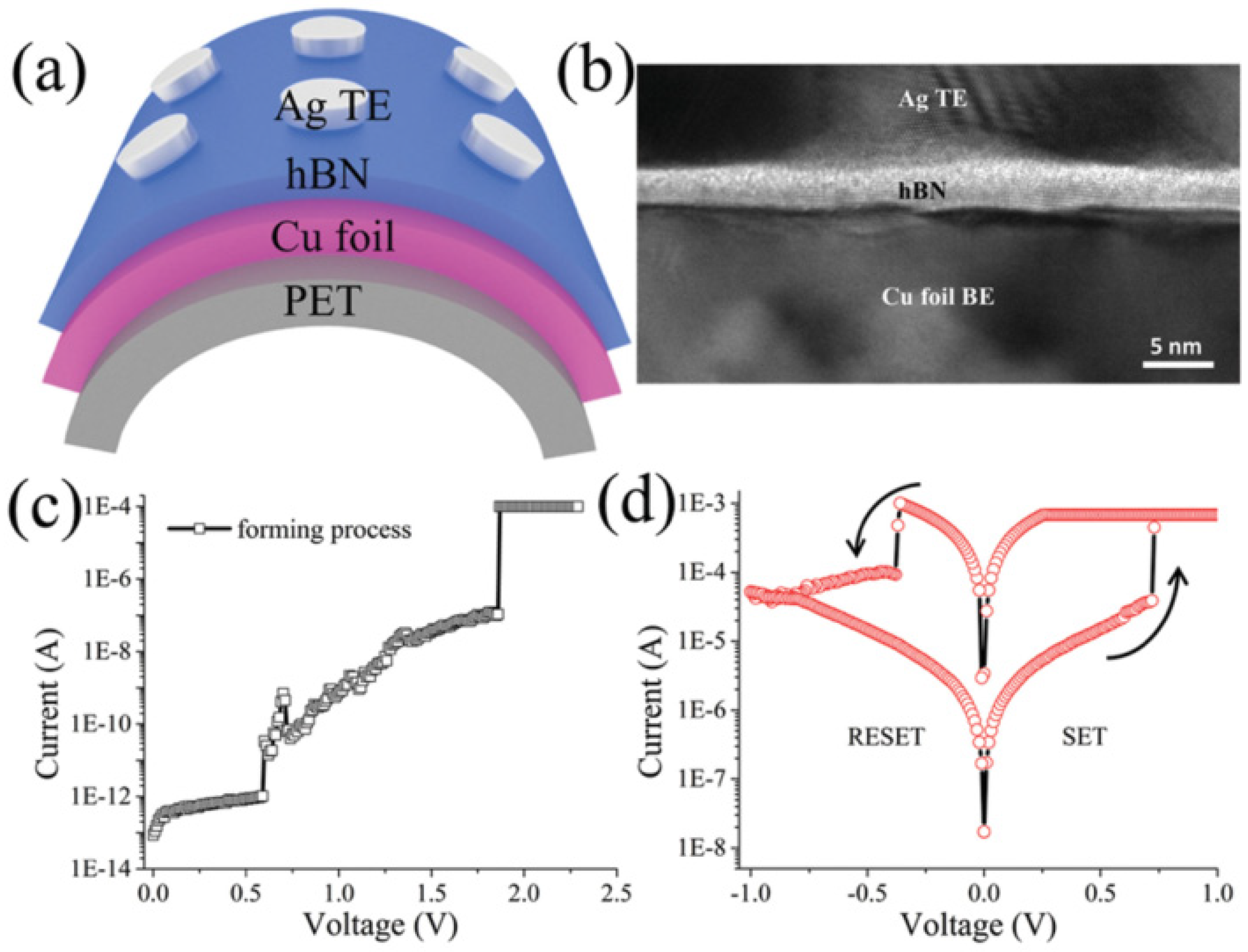

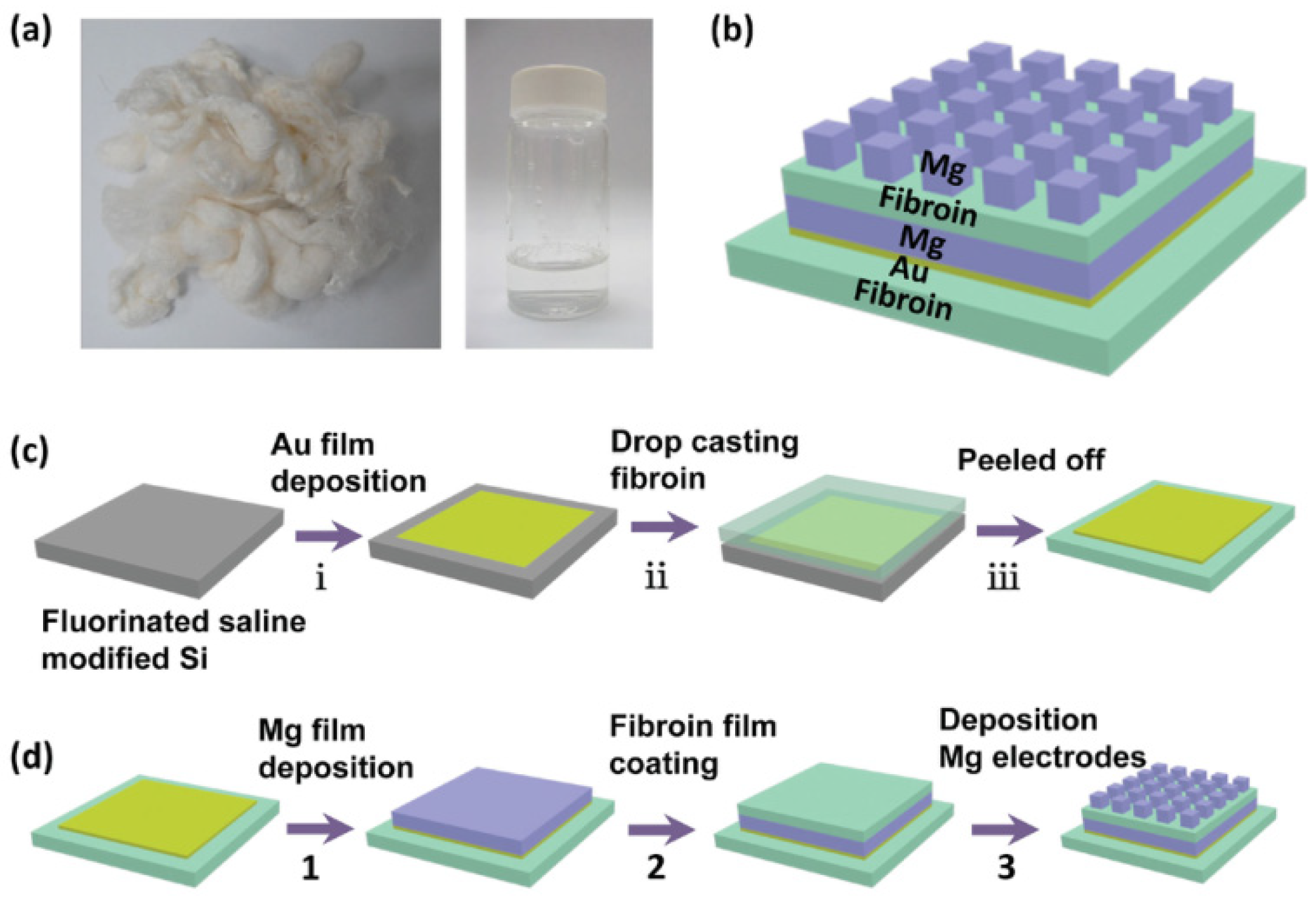


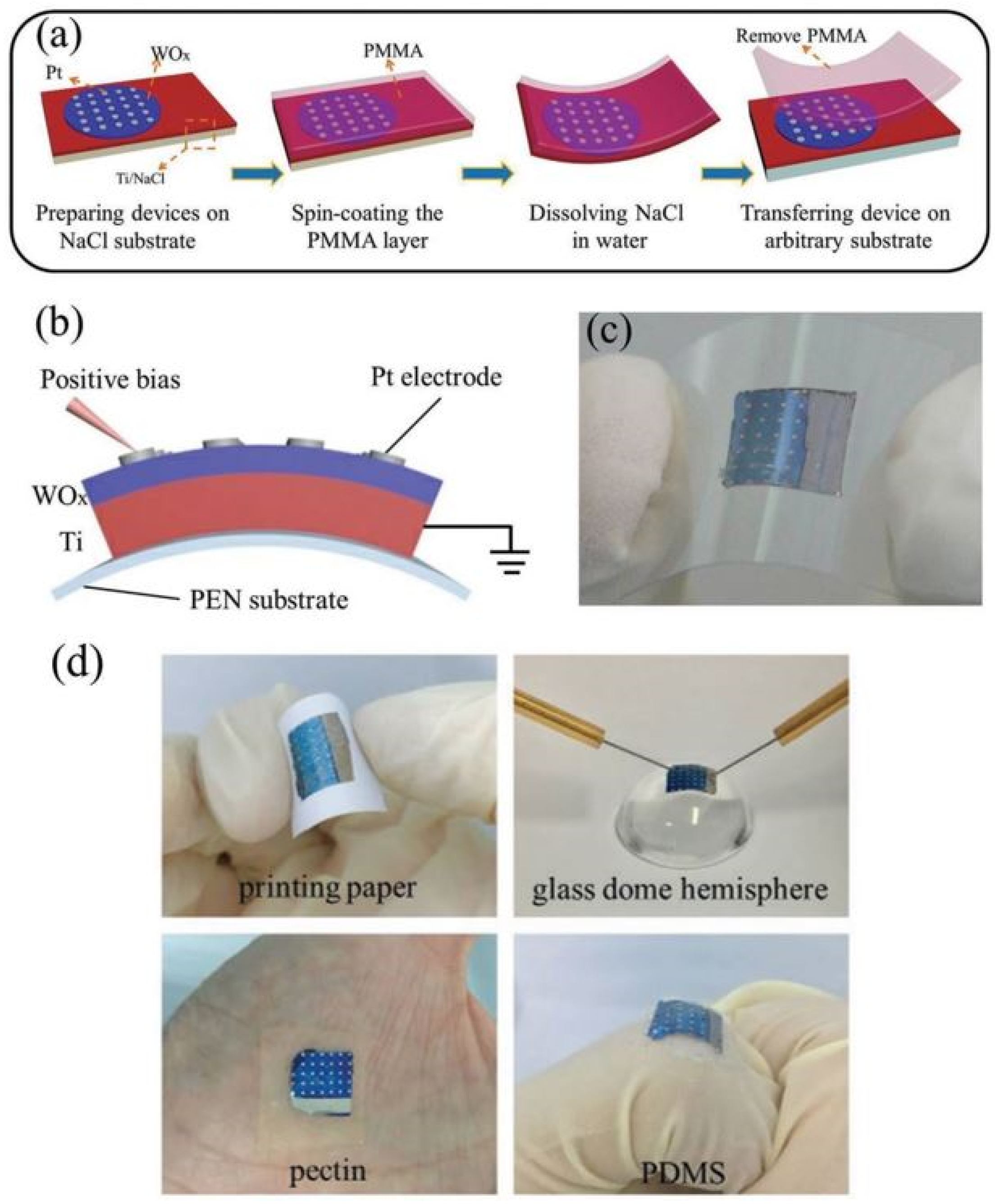
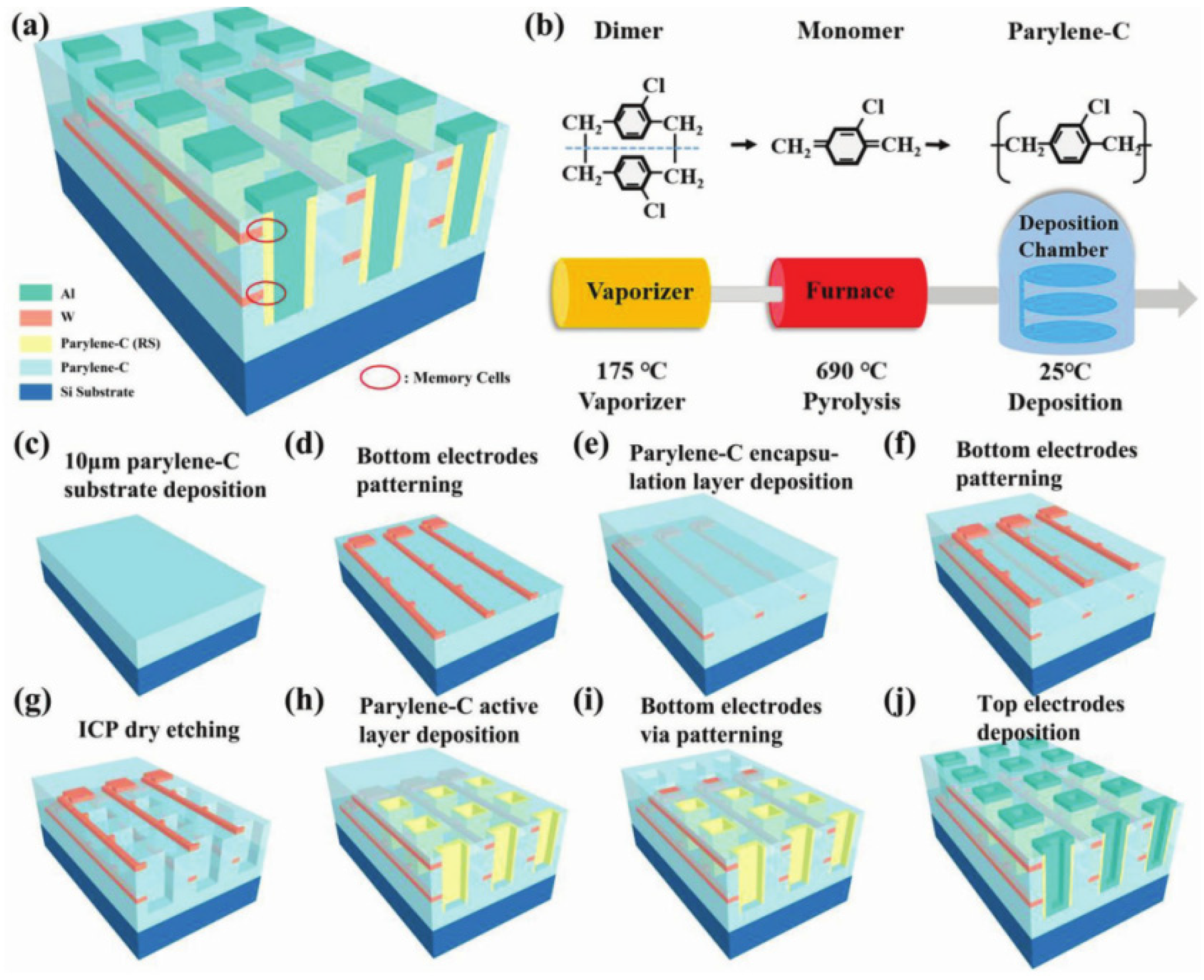
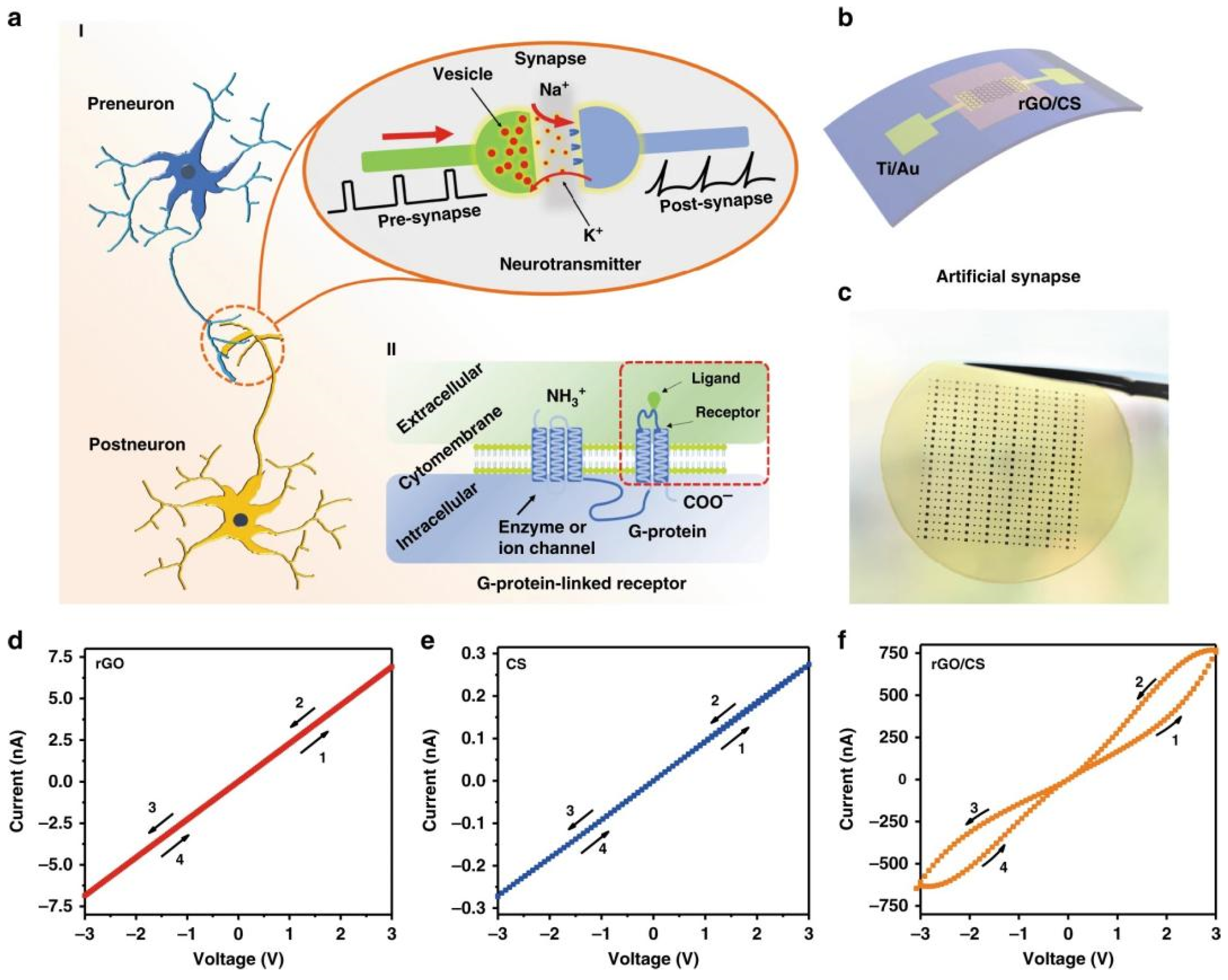
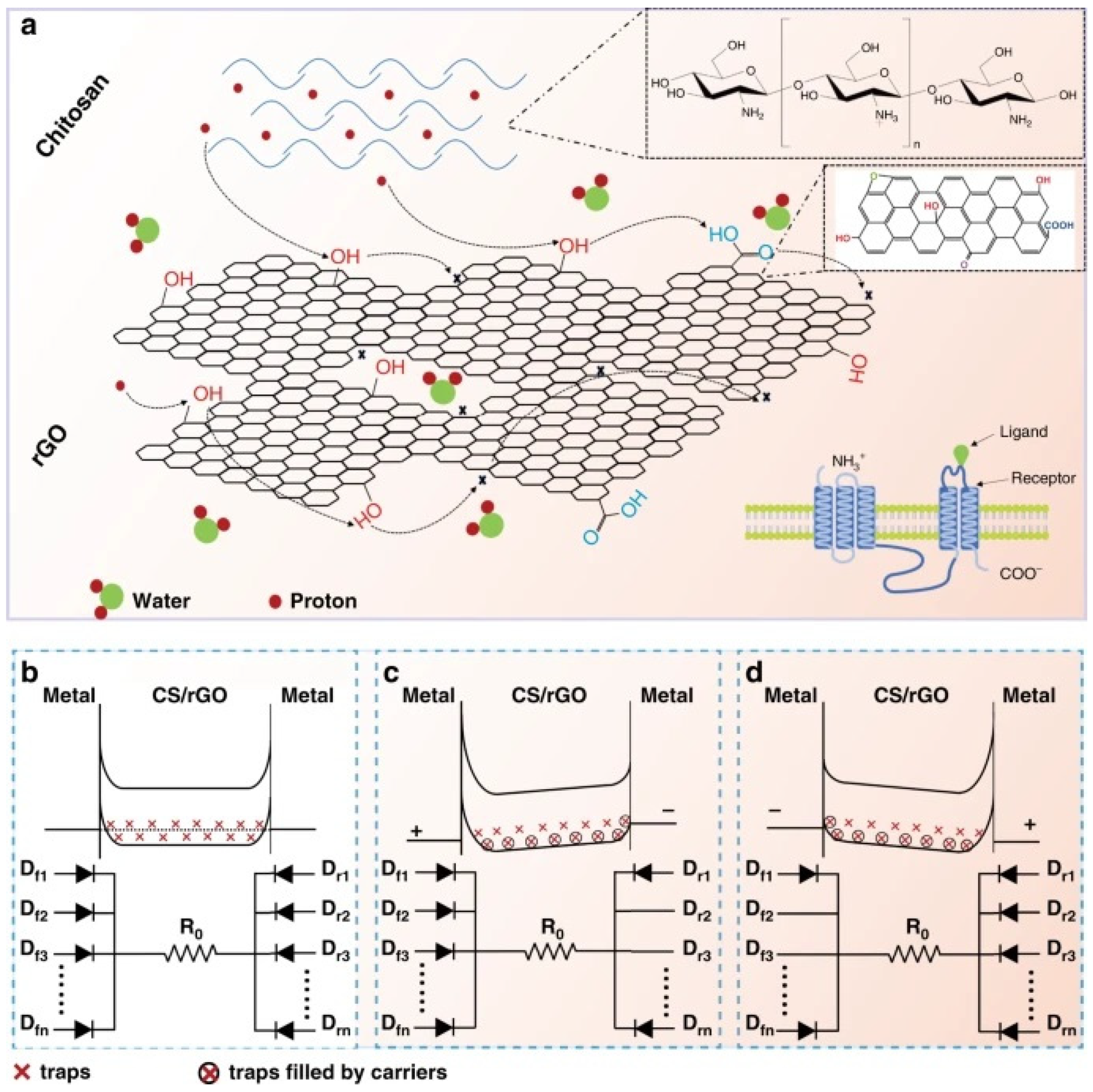
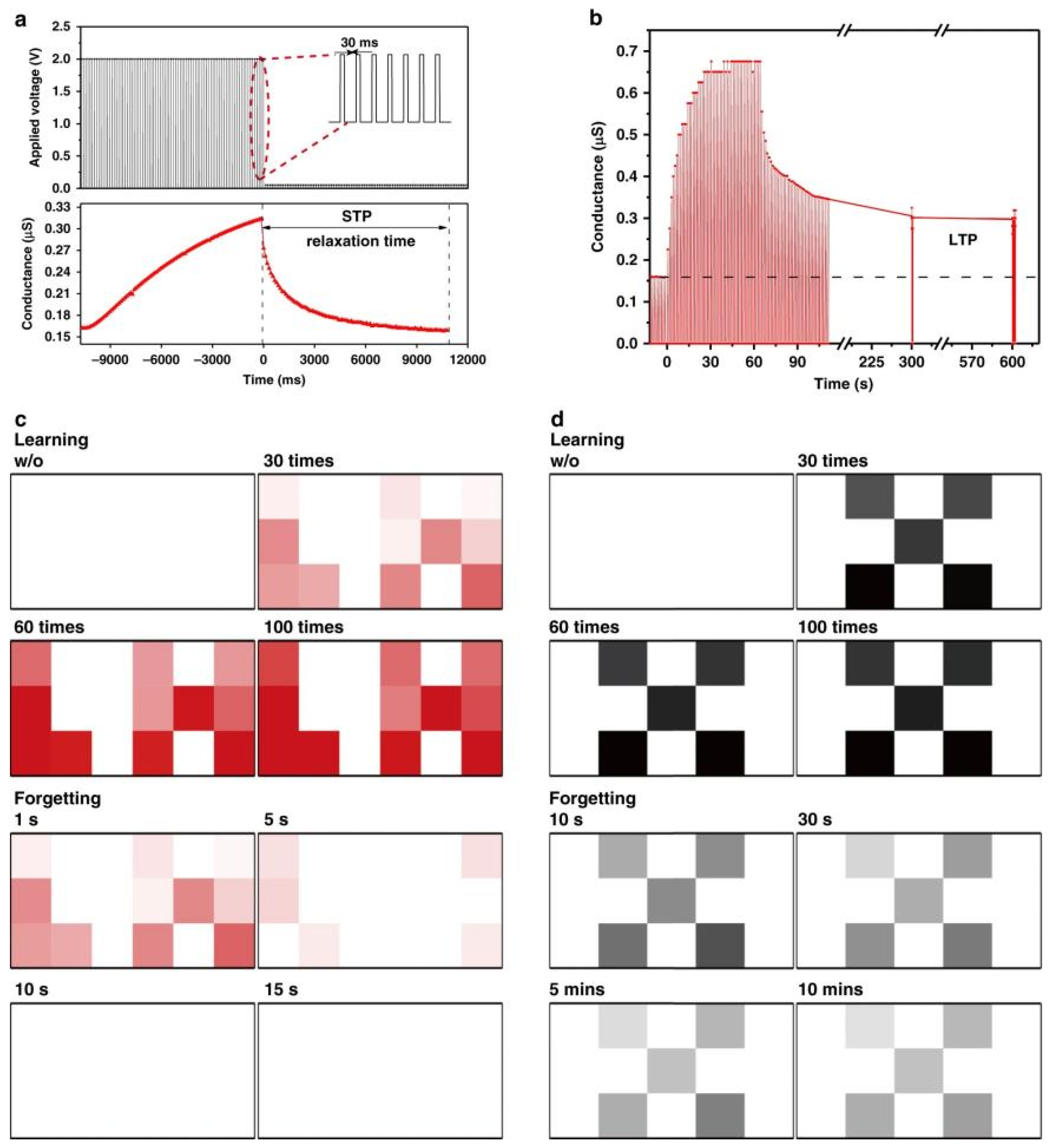
| Materials | Advantages | Disadvantages | Reference | ||
|---|---|---|---|---|---|
| Flexible memristor material | Metals | Ti | Degradability | High cost | [27] |
| Pt | [23] | ||||
| Mg | [24] | ||||
| Ag | [25] | ||||
| W | [78] | ||||
| Oxides | ITO | Transparency | High cost | [29] | |
| ZnO | [31] | ||||
| AZO | [32] | ||||
| Flexible dielectric layer material | Metal oxide flexible memristor | TiO2 | High memristive performance | Poor flexibility | [37] |
| HfO2 | [38] | ||||
| ZnO | [44] | ||||
| Organic polymers flexible memristor | PEDOT:PSS | High flexibility | Unsustainable development | [47] | |
| PV3D3 | [48] | ||||
| PMMA | [53] | ||||
| PDDF-g-MWNTs | [55] | ||||
| Parylene-C | [56] | ||||
| Two-dimensional materials flexible memristor | Graphene | High flexibility | High cost | [62] [65] [69] [71] | |
| HBN | |||||
| MoS2 | |||||
| WS2 | |||||
| Biodegradable materials flexible memristor | BSA | High flexibility Low cost Sustainable development Biocompatibility | Poor tolerance Device performance needs to be improved | [24] | |
| Egg white protein | [78] | ||||
| Gelatin | [79] | ||||
| Fibroin | [23] | ||||
| Lignin | [82] | ||||
| DNA | [83] | ||||
| Flexible substrate material | Organic flexible substrate material | PET | Low cost | Poor heat resistance | [27] |
| PDMS | [24] | ||||
| PLGA | [89] | ||||
| A4 paper | [90] | ||||
| Inorganic flexible substrate material | Muscovite | High temperature resistance | Complex preparation process | [91] | |
| NaCl | [93] | ||||
| Memristor | Retention Time (s) | SET/RESET Voltage (V) | ON/OFF Ratio | Stability | Flexibility | Reference |
|---|---|---|---|---|---|---|
| ITO/HfOx/ITO/PET | 105 | 0.4/−0.2 | ~40 | 108 pulse-mode switching cycles | Withstand a mechanical tensile stress of up to 2.12% | [30] |
| AZO/NiO/AZO/muscovite | 105 | 0.5 | >105 | Stable endurance to 103 cycles | Work at various bending radii down to 5 mm | [32] |
| ITO/TiO2/HfO2/Pt/PEN | 104 | 1.5/−1.5 | >10 | HRS and LRS resistances are estimated to be ≈ 3.2% and ≈ 3.0% | Withstand bending radius ranging from 70 to 10 mm | [43] |
| TiN/Al2O3/ZnO/Al2O3/TiN | >104 | 5 | >102 | Stable endurance > 104 cycles | Withstand a bending radius of up to 3 mm | [44] |
| 3D Al/parylene-C/W | >105 | 2.6/0.75 | >10 | Stable endurance > 300 cycles | Withstand bending conditions (radius <10 mm) | [56] |
| Ag/MgO-PVP-Gr/ITO | >104 | 4/−4 | 8.5 × 103 | Stable endurance to 500 cycles | Withstand various bending cycles after 100, 250, 500 cycles | [48] |
| Ag TE/hBN/Cu/PET | 3 × 103 | 0.72/−0.37 | 100 | Stable endurance to 550 cycles | Bending endurance ≈ 750 cycles | [65] |
| Ag/silk fibroin/Au/Parylene-C | 103 | 3/4 | 103–109 | Stable endurance to 30 cycles | Remains the same during bending over a cylinder with a radius of curvature of 1.3 mm | [82] |
Publisher’s Note: MDPI stays neutral with regard to jurisdictional claims in published maps and institutional affiliations. |
© 2021 by the authors. Licensee MDPI, Basel, Switzerland. This article is an open access article distributed under the terms and conditions of the Creative Commons Attribution (CC BY) license (https://creativecommons.org/licenses/by/4.0/).
Share and Cite
Zhang, H.; Liu, R.; Zhao, H.; Sun, Z.; Liu, Z.; He, L.; Li, Y. Research Progress of Biomimetic Memristor Flexible Synapse. Coatings 2022, 12, 21. https://doi.org/10.3390/coatings12010021
Zhang H, Liu R, Zhao H, Sun Z, Liu Z, He L, Li Y. Research Progress of Biomimetic Memristor Flexible Synapse. Coatings. 2022; 12(1):21. https://doi.org/10.3390/coatings12010021
Chicago/Turabian StyleZhang, Huiling, Ruping Liu, Huiqing Zhao, Zhicheng Sun, Zilong Liu, Liang He, and Ye Li. 2022. "Research Progress of Biomimetic Memristor Flexible Synapse" Coatings 12, no. 1: 21. https://doi.org/10.3390/coatings12010021






